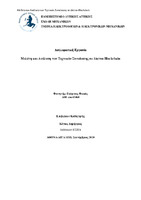| dc.contributor.advisor | Kogias, Dimitrios | |
| dc.contributor.author | Φωκάς, Γεώργιος | |
| dc.date.accessioned | 2021-04-12T10:18:08Z | |
| dc.date.available | 2021-04-12T10:18:08Z | |
| dc.date.issued | 2020-09 | |
| dc.identifier.uri | https://polynoe.lib.uniwa.gr/xmlui/handle/11400/556 | |
| dc.identifier.uri | http://dx.doi.org/10.26265/polynoe-407 | |
| dc.description.abstract | Σκοπός της διπλωματικής αυτής είναι η μελέτη και ανάλυση των βασικών και πιο διαδεδομένων μηχανισμών και τεχνικών συναίνεσης, μέσω βιβλιογραφικής έρευνας. Το Blockchain αποτελεί ένα κατανεμημένο σύστημα, αποτελούμενο από ομότιμους κόμβους, ασφαλές λόγω του αποκεντρωτικού χαρακτήρα του, της κρυπτογράφησης των δεδομένων καθώς και της χρήσης ψηφιακών υπογραφών που χρησιμοποιεί. Στον πυρήνα του έχει αποκεντρωτικό χαρακτήρα και λειτουργεί με βασικές αρχές όπως ανωνυμία και αμεταβλητότητα. Η τεχνολογία Blockchain έγινε γνωστό και περιζήτητο θέμα έρευνας για τον επιστημονικό τομέα αρχικά το 2008 μέσω της πλατφόρμας κρυπτο-νομισμάτων Bitcoin. Βασικό γνώρισμα της τεχνολογίας αυτής είναι οι μηχανισμοί και οι τεχνικές που πραγματοποιούνται ώστε να υπάρξει ομοφωνία στο σύστημα. Οι μηχανισμοί αυτοί αναλώνονται σε κανόνες και αλγοριθμικές διεργασίες που πρέπει να τηρούν οι συμμετέχοντες κόμβοι για ομαλή και αποδοτική λειτουργία σε ένα σύστημα Blockchain. Οι διεργασίες αυτές μεταξύ άλλων συνήθως αφορούν επίλυση πολύπλοκων μαθηματικών συναρτήσεων ή εκτέλεσης γύρων ψηφοφορίας ανάμεσα στους κόμβους, αναλόγως του μηχανισμού συναίνεσης που χρησιμοποιείται. | el |
| dc.format.extent | 59 | el |
| dc.language.iso | el | el |
| dc.publisher | Πανεπιστήμιο Δυτικής Αττικής | el |
| dc.rights | Αναφορά Δημιουργού - Μη Εμπορική Χρήση - Παρόμοια Διανομή 4.0 Διεθνές | * |
| dc.rights | Attribution-NonCommercial-NoDerivatives 4.0 Διεθνές | * |
| dc.rights.uri | http://creativecommons.org/licenses/by-nc-nd/4.0/ | * |
| dc.subject | Blockchain | el |
| dc.subject | Δίκτυα ομότιμων κόμβων | el |
| dc.subject | Κρυπτονομίσματα | el |
| dc.subject | Κατανεμημένα συστήματα | el |
| dc.subject | Κρυπτογράφηση | el |
| dc.subject | Bitcoin | el |
| dc.subject | Κρυπτογραφία | el |
| dc.subject | Peer-to-peer | el |
| dc.subject | Τεχνολογίες κατανεμημένου καθολικού | el |
| dc.subject | Distributed ledger technology | el |
| dc.subject | Αποκεντρικοποιημένα συστήματα | el |
| dc.subject | Αλγόριθμοι | el |
| dc.subject | Μηχανισμοί συναίνεσης | el |
| dc.subject | Proof of stake | el |
| dc.subject | Δημόσια συστήματα Blockchain | el |
| dc.subject | Κοινοπρακτικά συστήματα Blockchain | el |
| dc.subject | Ιδιωτικά συστήματα Blockchain | el |
| dc.title | Μελέτη και ανάλυση των τεχνικών συναίνεσης σε δίκτυα Blockchain | el |
| dc.title.alternative | Study and analysis of consensus techniques in blockchain networks | el |
| dc.type | Διπλωματική εργασία | el |
| dc.contributor.committee | Παπαδόπουλος, Περικλής | |
| dc.contributor.committee | Patrikakis, Charalampos | |
| dc.contributor.faculty | Σχολή Μηχανικών | el |
| dc.contributor.department | Τμήμα Ηλεκτρολόγων και Ηλεκτρονικών Μηχανικών | el |
| dc.description.abstracttranslated | Blockchain technology became a well-known and sought-after research topic in the scientific field initially in 2008 through the Bitcoin cryptocurrency platform. Blockchain usually refers to a distributed system, consisting of peer nodes, secure due to data encryption, digital signature and distributed nature. At its core it has a decentralized character and operates with basic principles such as anonymity and immutability. This fact makes it an interesting candidate to act as a medium for conducting online transactions through cryptocurrencies or other applications in the wider context of technology (e.g. smart contracts). The key feature of this technology is the mechanisms and techniques that are taking place in order to have consensus in the system. These mechanisms are referred to the rules and algorithmic processes that must be followed by the participating nodes for the smooth and efficient operation in a Blockchain system. These processes, among other things, usually involve solving mathematical functions or performing voting rounds between nodes, depending on the consensus mechanism used. The purpose of this thesis is the study and analysis of the basic and most widespread mechanisms and techniques of consensus, through literature research.
Starting from Byzantine Generals problem, the necessity for the existence of a consensus mechanism in distributed environments is strongly depicted. To the end, we have studied some of the basic and most common consensus mechanisms such as PoW, PoS, PBFT, DPoS etc. which are analyzed. in terms of efficiency, security, finality and speed of transactions. Finally, the three basic types of Blockchain systems, Public-Private-Consortium, are studied in terms of the differences that govern them in characteristics such as decentralization/centralization rate, anonymity, request for permission to participate in the consensus algorithm, etc. The results of the analysis of the consensus techniques and the systems were summarized in corresponding tables for easier reading of their most essential characteristics. | el |


